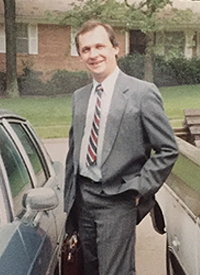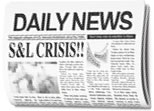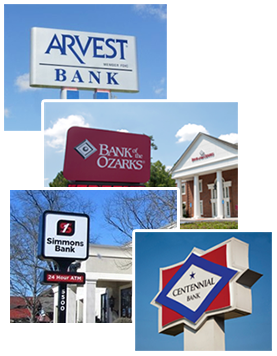We are proud of our 25-year history and we know we couldn’t have gotten here without a little help from our friends.
Yesterday
The DD&F story begins 25 years ago in 1993, when DD&F first opened its doors for business. However, to really understand the full picture, you need to know the back-story, or as Paul Harvey used to say, “the rest of the story.” Let’s wind the clock all the way to 1977 when a bright-eyed, 24 year old Randy Dennis moved to Little Rock, Arkansas at a pivotal time in the world of banking - for Randy, anyway.

Armed with a freshly printed MBA, a young wife and a two month old daughter, Randy jumped at the first - and almost only - job offer he received and entered the world of banking and finance through the doors of Arkansas Financial Services (“AFS”) in Little Rock.
Five years later, two more future DD&F’ers entered the picture – Bob Fegtly and Bill DaBoll. Bob Fegtly had just graduated with an MBA and moved to Little Rock looking for opportunities. On the first day after moving he looked up “consultants” in the yellow pages (we hope everyone still remembers yellow pages) and gave AFS a call. Lucky for him, he was hired and began to work alongside Randy. That same day, Bill DaBoll was also hired by AFS. Bill came from Chicago and brought with him real world consulting experience.
At this time, Little Rock was home to the Federal Home Loan Bank of Little Rock, which supervised savings and loans (“S&Ls”) across what was known as the 9th District, which included the states of Arkansas, Mississippi, Louisiana, Texas and New Mexico. All S&Ls in the region were regulated by the Federal Home Loan Bank of Little Rock, making Arkansas’ capital the center of the universe for S&Ls in those five southern states. It turned out to be the perfect place for Randy, Bob and Bill to learn the industry firsthand, and to form a great working team.
Eight Days a Week

Not only did Little Rock offer a unique regulatory opportunity, AFS turned out to be a very unusual company. It was actually owned by 75 S&Ls in Arkansas, allowing Randy, Bob and Bill to learn both banking and consulting from the inside out. It’s one thing to read about consulting in business school, yet quite another to actually provide value in the consulting process. AFS was the perfect training ground to learn about the importance of regulators and the regulatory world of preparing branch applications, evaluating banking markets, chartering savings and loans and facilitating mergers. The early 80’s were foundational for each of them and set the stage for the company that the three would later establish.
Between 1986 and 1988, the S&L world imploded. Triggered by a perfect storm of stagflation, plummeting oil prices in Texas, asset-liability mismatch and shifting regulatory policy, the S&L crisis marked the largest collapse of U.S. financial institutions since the 1930s. Between 1986 and 1995, 1,043 of the 3,234 S&Ls in the United States failed. Arkansas was particularly affected since some of the biggest thrifts to fail - First Federal of Arkansas, Savers Federal, First America and FirstSouth - were located in Arkansas and were even owners of AFS. Randy, Bob and Bill were located at ground zero of the resulting recovery efforts.
Congress passed the Financial Institutions Reform, Recovery, and Enforcement Act of 1989 (FIRREA) in order to help pick up the pieces of the broken S&L industry. FIRREA abolished the bankrupt Federal Savings and Loan Insurance Corporation, transferred the insurance coverage to the FDIC and created the Resolution Trust Corporation (RTC). The RTC was charged with closing, selling or merging troubled thrifts and disposing of assets. Arkansas was the site of one of the early RTC failures, First Federal of Malvern. After the thrift failed and was marketed, no bank bid on the deposits and as a result the insured deposits were paid out or liquidated. It was one of the first major failures of the RTC.
Seeing a great opportunity for Arkansas banks embedded in the S&L crisis, Randy approached the Arkansas State Bank Commissioner, Bill Ford, and convinced him that the failed S&Ls offered opportunities for Arkansas’ banks. Fortunately, Mr. Ford liked the idea. It was during this timeframe that Randy, Bob and Bill began building the relationships with bankers and regulators across the state and region which would drive the future growth of Arkansas banks.
The years from 1988 to the first half of 1992 were a blur as AFS capitalized on the failures throughout the south. AFS prospered during this time, but in June 1992, the failures all but stopped. It was during this lull in activity that the three realized they could not continue with AFS and its mission to serve the savings and loan industry because the S&L industry was rapidly nearing extinction. Something had to change.
1993: Bob Fegtly, Randy Dennis, Bill DaBoll
Come Together
Starting a new company from scratch though, was quite a bit different from leaving college at 24 for a new job. Randy was almost 40 and the father of not one, but seven children between the ages of four and sixteen. Bill also had a family with two children. It’s one thing to take a chance that affects just you; it’s another when your choices potentially affect your family. The sense of being responsible for generating enough business to sustain the partners and their families was difficult. Randy will tell you that in the months leading up to starting the new company, he did much soul searching and lost a good bit of sleep since their start-up would have zero clients and no work lined up. Whatever happened next was going to require a leap of faith.
When Cortez landed in Veracruz in 1519, he burned his ships, so his crew and army would be totally committed to conquering the Aztecs. It seemed God had placed the three founders in a similar situation. The RTC had pretty much burned the S&L “ships” that had carried Randy, Bob and Bill to 1992. There was no future at AFS nor any way to go back to the good old days. As a result, the three men reached an agreement to leave the company. On January 1, 1993, Dennis, DaBoll and Fegtly combined their initials, their collective knowledge and expertise and set out a shingle for DD&F Consulting Group.
In 1993, Randy Dennis, Bill DaBoll and Bob Fegtly combined their initials, their collective knowledge and expertise and set out a shingle for DD&F Consulting Group.
Even though the new company had a slow start, shortly after DD&F’s beginning, the lull in S&L failures ended and 11 more banks failed, providing enough opportunities for DD&F to gain traction as a bank consulting firm. New work came to the fledgling team at just the right time. God had answered the prayers.
Though an unlikely trio, Randy, Bob and Bill had the right mix of skills to make it work. Randy was the front man with the contacts and the ability to spin a deal. He often referred to himself as a “used bank salesman” as his career was essentially built on buying and selling banks from the ashes of the of the S&L crisis. Bill brought with him a seemingly endless knowledge of regulatory laws and intricacies. He was the expert of the feasibility study and an application guru. Bob established himself as a wizard with numbers. He could, and still does, sift through the financial implications of a transaction in his head within a matter of minutes. It was a skill that would come in handy many times over the next 25 years.
Shortly after the new firm was established, a fourth joined their ranks: John Hargrave. Though he initially came on in an unofficial capacity, John’s engineering mind and development skills proved essential to expanding into a company with a mission to serve financial institutions with a broad array of consulting and risk management services. John also understood the changing world of technology. This “one-stop” approach to consulting extended their services across the state and eventually the entire country. When Bill DaBoll retired in 2008, John took his place as the third partner.
Baby You’re a Rich Man

Money was tight in those early years and with the first job DD&F landed, a report needed to be bound. The partners still remember standing in Office Depot and discussing whether they should spend the $175 on a binding machine or see if they could borrow one somewhere. It was a monumental decision. DD&F’s greatest negotiation job at that time was not for the sale of a bank but for the purchase of a used copier machine. It was such a large purchase that the negotiation went on for weeks!!!
Office equipment wasn’t the only significant investment in DD&F’s early days. It was during its first year that DD&F made its home on the corner of Sixth and Rock Street in a grand old historic house that was the first of four the company would purchase at that intersection. Though money was tight, the 601 building was truly a family and friends project that came together through hours of hard work and more than a little sweat equity. It was amazing to see friends and family helping in so many ways to help DD&F succeed with this new venture. During these times the partners filled the shoes of admin assistant, bookkeeper, repairman, coffee maker and even janitor. No job was too small.
Act Naturally
Banking is one of the few businesses where honor and integrity are required by law.
No company can be successful without a clear mission. For DD&F, that wasn’t too complicated. Banking is one of the few businesses where honor and integrity are required by law. As keepers of personal and business monies and an industry commitment to building communities, banks have a very high bar when it comes to integrity and confidentiality.
For DD&F to effectively serve its banking clients, it was critical that the consulting team operate under a commitment to absolute integrity and confidentiality. To take its commitments a step further, rather than setting lofty goals for personal success or focusing on growing DD&F’s bottom-line, a culture of servant leadership was established through DD&F’s simple mission and ultimate goal to MAKE ITS CLIENTS SUCCESSFUL.
This mission statement is the bedrock belief of DD&F. In order to pursue that mission, the entire DD&F team committed itself to staying at the leading edge of the banking industry’s constantly changing environment, continuously refining their services and solutions to bring the greatest level of success to its clients.
Ticket to Ride
Little did the partners know the roller coaster ride that the industry would take over the next 25 years. In 1994, the Riegle-Neal Act paved the way for expansion and branching across state lines. DD&F was in the thick of it, filing branch applications and merger applications for ambitious Arkansas banks.
Glass-Steagall was repealed, the Gramm-Leach-Bliley Act passed and the world braced itself for Y2K and the end of the millennium. Although Y2K passed peacefully, the pace of change in the banking industry didn’t slow in the new millennium. Since the year 2000, the banking industry experienced a reduction in total number of banks from both open bank acquisitions and also through failed bank acquisitions.
Bank failures accelerated across the US, and the DD&F team’s firsthand experience from the S&L crisis and open bank mergers and acquisitions came in handy...
Changes continued with the great recession of 2007/2008 with the bursting of the housing bubble and a genuine worldwide financial crisis. Bank failures accelerated across the US, and the DD&F team’s firsthand experience from the S&L crisis and open bank mergers and acquisitions came in handy as DD&F responded. DD&F developed comprehensive training and bidding models for their clients and helped “recycle” the failed banks through failed bank acquisitions across the country. DD&F’s clients were some of the first failed bank buyers and as a result, profited handsomely from these transactions.
In 2010, the Dodd-Frank Wall Street Reform and Consumer Protection Act was intended to reform Wall Street, but the collective increase of tightening regulations and oversight put a heavy burden on community banks as well. Over the next four years, bankers would face tighter regulations and more stringent capital requirements. Furthermore, they would have to manage changes in technology (Fintech) and the added burden of cyber security, the effect of social media, speculation about currency changes, the question of how to attract the next generation of bankers and the matter of restoring a positive reputation for the banking industry. During all of these years of compounding new challenges, DD&F has remained focused on helping its clients adjust to the constantly changing world of banking.

With a Little Help from our Friends
The waves of change have continued over the past 25 years, and DD&F has responded by helping banks branch across the state or country, assisting investors with chartering new banks in the late 90’s and early 2000’s, merging or acquiring and growing existing entities for banks, and helping smaller community banks find new ways to serve their customers. Some would grow into powerhouses like Arkansas’ Arvest Bank, Bank of the Ozarks, Centennial Bank and Simmons Bank. But no matter the size of goals of its clients, DD&F has never lost sight of its mission to help make its clients successful. Through the hard work and commitment of its team of consultants, DD&F has grown to become a nationally-respected company serving clients across the country.
Today: John Hargrave, Bob Fegtly, Randy Dennis
And now you know the rest of the DD&F story
Relationships have always been at the heart of our business, and today we recognize that fact more than ever. Though we’re proud of our history, we know we wouldn’t be where we are without you – the clients, regulators and professional partners we've been privileged to work with. This 25 year milestone could only have been reached with a little help from our friends.



